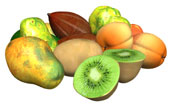 by Steven H. Horne, Herbalist
by Steven H. Horne, Herbalist
In 1984, I went to work for Nature’s Sunshine Products in Spanish Fork, Utah. The top two best-selling products at the time weren’t Silver Shield or Thai-Go, they were LBS II and cascara sagrada. Psyllium Hulls Combination was also in the top ten.
The bottom line is that in 1984, colon cleansing was our number one focus. I’d been involved in herbs and natural healing since my late teens, so I was familiar with the idea of cleansing, but I wasn’t prepared for the level of “potty talk” I was about to experience.
I remember sitting at a formal banquet at my first Nature’s Sunshine National Convention and listening to a very frank discussion on bowel movements. It wasn’t something I was used to hearing people talk about at all, let alone discussing it over dinner.
While I’m still not sure that the dinner table is the appropriate place to discuss it, we do need to educate people about bowel health because it is just as important now as it was back then. People are just as “full of it” today as they were in 1984.
The natural healers whose legacy NSP is built on, including John Christopher, Bernard Jensen, Stan Malstrom and LaDean Griffin, all stressed the importance of maintaining a healthy colon. That’s because good elimination has been recognized as a key component of good health for thousands of years. I know the idea of colon cleansing is “pooh-poohed” (pun intended) in medical circles, but no matter what the medical “experts” say, I’ve personally experienced the benefits of doing a cleanse.
Of course, some people overdo the cleansing thing and I’ve seen cases of that, too. Still, I believe that doing a complete cleanse once or twice a year is a good health practice. I also think it’s important to maintain healthy elimination every day for general good health. Cleansing is a particularly important therapy since most Americans continue to primarily eat processed foods and all of us are exposed to the pollutants and toxins of our industrial civilization.
Unfortunately, few people understand what healthy elimination is supposed to be like, so they don’t realize that they’re actually constipated. Most people think that going once a day and passing hard, round stools is normal. Well, it may be common, but it isn’t healthy.
So, people need to be educated about healthy stools, and as the saying goes, “It’s a dirty job, but somebody’s got to do it.” (Maybe it should be a topic for that TV show, Dirty Jobs.) Anyway, fortunately (and perhaps unfortunately, if you’re squeamish about the subject) I’ve gotten over the reservations I had in 1984 about discussing the topic of healthy stools. So get ready to be educated.
What is a Healthy Stool Like?
First of all, a healthy stool should be soft, loosely formed and easy to pass. If you regularly have to strain to eliminate, consider yourself constipated.
Second, your stool should come out in long pieces (6-8 inches in length) that should be about as thick as two fingers (your index and middle finger in particular). If your stool passes in hard round balls or big thick logs, you’ve got elimination problems.
Third, unless you’ve got a food in your diet that’s coloring it (like beets or liquid chlorophyll), your stool should be a light brown color. If it is consistently black or a very dark greenish-brown, your liver and gallbladder need some help. You’ve also got gallbladder problems if your stool is very pale (a light clay color).
Fourth, contrary to popular belief your “stuff” shouldn’t stink. That is, your stool shouldn’t have a rank odor when you pass it. If it does, you’ve got a toxic condition in your bowel—not healthy!
Fifth, you should generally eliminate about two to three times per day depending on how often you eat. I’ve had people dispute me on this fact, but here’s the main reason why I believe this is true.
The digestive tract is divided into three separate areas by a system of valves, so digestion takes place in three distinct stages. Food is first handled in the stomach, then in the small intestines and then finally in the colon. Each section of the digestive tract should empty itself in preparation for the next meal. The digestive organs need to rest between meals.
Think of this like a train with three cars. Add one car to the front and it pushes each car to the next station. The car that was last is removed. What is happening in most of our digestive tracts is a train wreck, with five or six or maybe even ten meal’s worth of material in the digestive tract at any given time. Basically, I believe if we eat three main meals a day we should be eliminating about three times a day, too.
Which leads right into point number six. Colon transit time should ideally be 16-18 hours and certainly less than 24 hours. In other words, it should take about 16-18 hours for any meal to be completely processed and eliminated. If it remains there any longer than this, it becomes an irritant to the system and we wind up absorbing these irritants into the system.
Again, I realize that most people from the medical community will tell you that all of this is nonsense, but from personal experience I can tell you that you’ll have more energy, less pain and stiffness and feel better overall when your colon transit time is less than 24 hours.
An easy way to test your colon transit time is to eat a meal with some beets. Beets cause a red color to pass in your stool. If you eat a couple of beets at dinner time and this red color passes completely the next evening, your colon transit time is fine. If it doesn’t pass until two or three days later, you’ve got problems with colon transit time.
Now, don’t get all worried if you don’t have the perfect stool. Much of the time I don’t. In fact, from time to time I get lazy about taking my fiber or enzymes and pretty soon I’m winding up passing hard round balls. At the same time, I usually start suffering from sinus congestion, neck pains, headaches and fatigue. When I get back to keeping my colon working properly, all these problems disappear. That’s why I’m sold on the idea that what I’m telling you is true.
So, don’t worry. Being a little constipated isn’t going to kill you or make you deathly ill, at least not right away. Just get off your behind and do a little cleansing and soon your behind will be working properly again.
The Colon Cleansing Toolbox
Before you do any job, you need to assemble the right tools and know how to use them correctly. So, in order of importance, here are the tools you need to cleanse the colon and keep it functioning properly.
Cleansing Tool #1: Water — It Washes You Inside, too.
 Water is the most important cleansing agent the body needs. Every eliminative system—the colon, the sweat glands, the kidneys and the lungs—requires water to function properly. When doing any kind of cleanse, it is important to drink ample amounts of pure water. In fact, drinking pure water is one of the best ways to keep your body clean on an on-going basis.
Water is the most important cleansing agent the body needs. Every eliminative system—the colon, the sweat glands, the kidneys and the lungs—requires water to function properly. When doing any kind of cleanse, it is important to drink ample amounts of pure water. In fact, drinking pure water is one of the best ways to keep your body clean on an on-going basis.
Most people in modern society are dehydrated. When water is in short supply, the body rations it for important organs like the brain. One of the ways the body conserves water is by absorbing more water from the colon. So, if your stools are dry and hard as are those of most people, you are dehydrated.
Another sign of dehydration is dark urine. Urine should be colorless to light yellow. When water is in short supply, the body concentrates more toxins into a smaller amount of water, resulting in dark urine. (An exception to this is that certain vitamin supplements will cause urine to become dark yellow as the body passes the excess vitamins.)
A quick test for dehydration is to pull up the skin on the back of your hand. If it bounces back quickly, you have good hydration. If it goes back slowly, you are dehydrated.
Thirst alone is not an adequate indicator of dehydration. Most people learned to ignore thirst at a very early age and so the natural impulse to drink water has disappeared. Also, the signal for food and water originate from the same place in the brain. Many people mistake the two and eat when they are really thirsty. In fact, when people are dehydrated, they tend to eat two to three times more than they need. This is why increasing water intake helps reduce appetite and aids in weight loss.
Pain can also be a symptom of dehydration. Pain is usually due to a lack of oxygen and an increase in toxic accumulation around the cells. Most pains will improve or even completely disappear when the body gets enough oxygen and water.
Many experts suggest that a person needs half an ounce of water per pound of body weight each day. A half gallon of water (two quarts) is 64 ounces, which is about right for a person who weighs 130 pounds. A person who weighs 190 pounds will need about three quarts of water per day.
The water we drink should be pure. I’ve consumed reverse osmosis water for years and lately, have been using Kangen water, which is even better. But the very least you should do is get a carbon filter for your tap.
Cleansing Tool #2: Fiber — It Keeps Your Intestines Running Smoothly
 After water, fiber is the most important thing the colon needs for detoxification. When most people think of fiber, they think of coarse fiber like bran or cellulose. This non-soluble fiber is rightly called roughage.
After water, fiber is the most important thing the colon needs for detoxification. When most people think of fiber, they think of coarse fiber like bran or cellulose. This non-soluble fiber is rightly called roughage.
While we need some roughage for colon health, the fiber we need the most is soft fiber that absorbs water in the form of mucilage, gums and pectin. This type of fiber isn’t rough at all. In fact, it is slippery and slimy and soothing, which is why I call it smoothage.
Water soluble fibers perform several important roles in maintaining colon health. First of all, by absorbing water, they help to bulk the stool and keep it soft. (If you drink enough water, of course). This creates a bulk laxative effect which makes the stool easy to pass. In other words, fiber keeps you “moving.”
But fiber does much more than help the colon move properly. It slows the absorption of fats and sugars into the bloodstream. This keeps the blood sugar levels stable. It also reduces appetite, because it swells with water and fills the stomach providing a physical sensation of fullness.
Smoothage also absorbs toxins and keeps them from irritating the mucus membranes of the intestinal tract. This makes it extremely valuable in combating inflammatory bowel disorders. Plants containing this type of soft fiber tend to encourage healing and tissue repair at the same time.
Fiber absorbs the bile coming from the gall bladder. A large portion of bile is cholesterol and by absorbing this cholesterol, it is removed from the body, thereby reducing cholesterol levels. More importantly, it also binds toxins that the liver puts into the bile to eliminate them from the body.
In fact, it is this absorbing of toxins that produces the strange material people often pass on a cleanse. When I first got involved in natural healing, I was told that the dark, slimy or rubber stuff one passed when doing a cleanse was encrusted fecal matter from the intestinal tract. As I studied the matter more carefully, I came to realize it was not.
It is the toxins (and most probably the toxic bile) that the fiber absorbs that produces this strange material. If you keep taking the fiber, eventually you’ll stop getting this dark material in your stool. When your stool becomes uniform, soft and light brown you’ll know your system is clean. In my experience this can take anywhere from six weeks to several months, depending on how toxic your liver and digestive tract are.
Nature’s Sunshine has four fiber supplements to choose from: Everybody’s Fiber, LOCLO, Nature’s Three and Psyllium Hulls Combination. I’ve listed them in order of gentleness. That is, Everybody’s Fiber is the mildest product and the one most suitable for people with intestinal inflammation and irritation. Psyllium Hulls Combination is the most bulking of the formulas and the best one for getting a bulk laxative effect.
As an interesting experiment, get some other companies fiber products and do a little test. Put a teaspoon of Psyllium Hulls Combination into a cup of water. Put the same amount of each competitive product into a cup of water, too. You’ll probably discover that Psyllium Hulls Combination will absorb more water than any competitive product.
I personally tend towards dehydration and developing a dry stool. I’ve discovered that the best fiber for me is to mix equal parts of Psyllium Hulls Combination with freshly ground flax seeds. The flax seeds are very lubricating and as long as I take this blend and drink plenty of water, my colon works pretty good.
If you’ve never taken fiber before, let me make a few recommendations. First of all, if you have a bowel movement less than once a day or your colon transit time is longer than two days, I would suggest you take a stimulant laxative like LBS II for a couple of days before starting to take fiber. Otherwise, the fiber may just add to the “train wreck” that’s already going on in your digestive tract.
I also recommend that anyone who hasn’t taken fiber before should start slowly. Try a gentler fiber like Nature’s Three or LOCLO first and take just a teaspoon per day to start. Work your way up to a heaping tablespoon over a period of two to three weeks.
Don’t bother taking fiber if you aren’t going to drink enough water. It won’t do you much good and may actually constipate you worse.
Fiber is also the safest of all cleansing remedies. It can be used by the elderly, pregnant and nursing women, and people who are weak and feeble. Even young children can use fiber like slippery elm and marshmallow. In fact, both slippery elm and marshmallow are mild nourishing foods, which can help people who are recovering their health after serious illness.
When you take fiber, put it in a little water or non-acidic fruit juice. Stir it with a fork until it barely dissolves, then drink it quickly. Follow it with a full glass of water. The best time to take fiber is first thing in the morning at least 15 minutes before breakfast. You can also take fiber before dinner.
Avoid taking medications or nutritional supplements with your fiber. It slows the absorption of nutrients and can interfere with medications.
Cleansing Tool #3: Enzymes — Breaking Down Both Food and Toxins
 I’ve taken plant enzymes since the early 1990s. I’m an A Blood Type and we have a hard time with digestion, so I’ve found enzymes to be one of the best supplements I’ve used. I wrote an extensive article about them, entitled Enzymes: The Most Important Supplement I Take, which you can read at www.steven-horne.com.
I’ve taken plant enzymes since the early 1990s. I’m an A Blood Type and we have a hard time with digestion, so I’ve found enzymes to be one of the best supplements I’ve used. I wrote an extensive article about them, entitled Enzymes: The Most Important Supplement I Take, which you can read at www.steven-horne.com.
Next to fiber, enzymes are the most important tool we have for detoxification, because they break down undigested foodstuffs in the intestines and reduce intestinal congestion. They are particularly helpful for this when taken between meals.
Thomas Easley introduced me to the idea that enzymes can detoxify the body. I discovered that taking 2 capsules of an enzyme product like Proactazyme Plus every two hours along with lots of water would clear out my intestinal tract within four to eight hours. Now, I take enzymes when I take my fiber drink in the morning to aid in detoxification. This is in addition to the enzymes I take with meals.
Good enzyme products to consider for colon cleansing are Proactazyme Plus, Hi Potency Protease, Small Intestine Detox and Bowel Detox. Bowel Detox is actually a blend of fiber, enzymes and some cleansing herbs (which we’ll talk about next), making it a great enzyme product for detoxification.
Cleansing Tool #4: Cleansing Herbs — The “Soap” That Washes Your Insides Clean
Everything we’ve discussed so far is stuff that you can take every day to maintain a healthy colon. What we’ll be discussing next is stuff to take when you’re doing a cleanse. I do not recommend taking cleansing herbal formulas on a daily basis. I think it’s excessive. You should use these herbs to kick start your eliminative functions and then, use them occasionally for a full blown cleanse.
There are many herbs that aid the function of eliminative systems of the body. Many of these herbs work because the body activates eliminative organs to get rid of some of the herbal constituents themselves.
Bitters are probably the most detoxifying of all categories of herbal remedies. Bitters generally aid liver function, increase bile flow and have a mild laxative action. They may also be diuretic and antimicrobial.
The second most detoxifying category of herbs is pungent herbs. Plants with a spicy taste tend to expel excess mucus, stimulate digestion and promote sweating.
Salty herbs also have some ability to aid in detoxification. They generally aid lymphatic and kidney function.
Herbal formulas designed to aid in detoxification generally focus primarily on bitters, but usually include some salty and pungent herbs, too. Thus, these formulas help to open up all the channels of elimination.
My favorite cleansing formula, and the one I used on my first major colon cleanse, is All Cell Detox, previously known as Special Formula #1. Two other formulas that fit into this category are Enviro-Detox and Liver Balance.
Back in the 1980s, all I did to cleanse was take All Cell Detox (2 capsules three times daily) and Psyllium Hulls Combination (twice daily). I passed a lot of dark rubbery material, then a lot of mucus and finally wound up with a really healthy stool (long pieces, light brown color and easy to pass). At the same time, my sinus problems completely cleared up for the first time in my life and I felt really clean and full of energy.
I’m doing a cleanse again as I write this, primarily because my sinus problems have come back and I know my colon needs some more help. This time, however, I’m also using enzymes as part of the program.
Cleansing Tool #5: Herbal Laxatives — When You Need That Little Extra “Push”
I don’t recommend herbal laxatives on a cleanse unless you really need them. Laxative herbs like cascara sagrada and senna contain compounds called anthraquinone glycosides. These compounds are yellow-brown dyes and when taken regularly, they stain the colon. This staining doesn’t appear to cause any harm, but it does alarm proctologists doing rectal exams.
However, the staining isn’t the reason I don’t recommend them. Yes, stimulant laxatives increase colon transit time, helping waste move more quickly through the body, but they don’t really “clean” the colon. Fiber and enzymes do.
Also, a large part of “colon cleansing” is actually cleansing the liver. The liver enzymatically neutralizes a variety of toxins, including heavy metals and then dumps them into the colon via the bile. Fiber absorbs the bile (and the toxins) so they are carried out of the body.
Many cleansing herbs appear to work by aiding liver function and stimulating bile flow, so formulas like All Cell Detox do the real work of detoxifying. Also, All Cell Detox and Enviro-Detox contain a small amount of cascara sagrada, which is sufficient to get the job done for many people.
The main reason I don’t recommend herbal laxatives, except for the occasional (annual or semi-annual) cleanse is that one can become dependant on them. My first herb teacher, Ed Millet, said this wasn’t the case, but my personal observation is that he was incorrect. I’ve seen too many people who seem unable to “go” without them.
Samuel Thomson had a negative view of herbal laxatives, too. He said, “Physic [herbal laxatives] I would by no means choose; to have you first or last to use; for if you use it much in course; it will disorder reinforce.” I think he was right, because anything which over-stimulates cleansing mechanisms tends to deplete the system over time.
This is why I’ve been encouraging NSP to come out with another laxative product that isn’t based on stimulant laxatives. This past year they finally released the product and I really love it. It’s called Gentle Move and I’m excited to tell you all about it, because it’s a product that can help tonify your colon and return normal eliminative function when you use it with water, fiber and enzymes.
Gentle Move: A New Tool for Colon Health
Gentle Move is an effective alternative to herbal stimulant laxatives. It helps to hydrate the colon and improve bowel tone to promote natural elimination. It can be used to wean someone off of stimulant laxatives and restore normal tone to the colon.
The key ingredient in Gentle Move is magnesium hydroxide, a salt of magnesium that attracts water to the bowel. This helps hydrate the stool and make it easier to pass. Magnesium hydroxide is found in milk of magnesia, an over the counter laxative.
Straight magnesium hydroxide can cause diarrhea and loss of potassium. It can also interfere with the absorption of iron and folic acid. However, in Gentle Move, a smaller amount is used along with a blend of herbs that help to tonify and rebuild the colon.
Gentle Move contains a blend of three herbs used in Ayurvedic medicine in India called Triphala. Triphala is a blend of three fruits that has been used as a gentle laxative, bowel tonic and blood purifier in India for thousands of years. It is such a beneficial formula that there is a saying in India, “No mother? Do not worry if you have Triphala.”
The first fruit in this blend is haritaki (Terminalia chebula). It has a balanced energy containing five flavors (bitter, sour, astringent, salty and sweet). It is a mild laxative that also tones the intestinal membranes. It lubricates tissues and relaxes muscle spasms. It is used for nervousness and anxiety as well as chronic constipation.
The second fruit in this blend is bibhitaki (Terminalia belerica), an antispasmodic herb that is pungent and warming. It is an expectorant and decongestant and used to treat asthma, bronchial problems and allergies.
The third, and final, fruit in Triphala is amalaki or Indian gooseberry (Embilica officinalis) which also has a balanced energy containing five flavors (sour, astringent, sweet, pungent and bitter). It contains a small amount of anthraquinones, but is also astringent, so it has both a laxative action and a bowel toning action. This means it corrects both constipation and diarrhea. It is a cooling remedy and is also used to treat ulcers, intestinal inflammation, burning sensations, skin eruptions and infections.
Triphala Benefits
The Triphala blend contains all the flavors (or tastes) used in Ayurvedic medicine, so it is considered a harmonizing or balancing remedy and is safe for long term use. Besides normalizing colon function, it improves liver function, protects the liver against environmental toxins and improves digestion.
Triphala’s benefits extend far beyond the digestive tract. It has both antioxidant and anti-inflammatory properties, so it slows aging and protects the body from degenerative disease. It enhances circulation, lowers blood pressure and protects the heart. It helps expel mucus from the respiratory passages and fights infection. It also supports healthy adrenal function.
In Ayurvedic medicine, Triphala is used for constipation, indigestion, flatulence, poor appetite, digestive headaches, sinus congestion, joint pain and general toxicity. It is also used for eye problems, general weakness and lethargy.
The combination of magnesium hydroxide with Triphala is powerful enough, but Gentle Move also contains four other herbs—yellow dock, ginger, slippery elm and marshmallow. Yellow dock is an iron-rich blood purifying herb. It enhances iron assimilation (which counteracts one of the side effects of magnesium hydroxide).
Other Herbs in Gentle Move
Like amalaki, yellow dock contains a small amount of anthraquinones, but is also astringent, so it corrects both constipation and diarrhea. It reduces inflammation (or heat) in the digestive tract and is useful for people with geographic tongues.
Ginger stimulates digestion and improves blood flow in the pelvic region. It is also anti-inflammatory, so it relieves digestive irritation.
Slippery elm and marshmallow are soothing mucilaginous herbs that have a mild bulk laxative action. (However, they aren’t present in sufficient quantities in this formula to have these effects.) They do, however, help to soothe and lubricate the colon.
Benefits of Gentle Move
When you put all the benefits of Gentle Move together, you can see that the formula provides a mild laxative action while tonifying and improving colon health. It reduces intestinal inflammation and helps normalize bowel function in people who have become dependent on stimulant laxatives.
It is a safe bowel formula for people who are suffering from inflammatory diseases of the digestive tract. It is also safe for pregnancy.
Gentle Move may also help to relieve skin conditions, sinus problems and respiratory congestion. It also aids and protects the liver.
Suggested Use
A safe long-term dose of Gentle Move (for maintenance of normal bowel function) is 2 capsules once or twice daily. People who have serious constipation problems or have become dependent on stimulant laxatives for normal bowel function will need to start with a higher dose, about 6-9 capsules daily. This could be 2-3 capsules three times daily or 3-4 capsules twice daily (morning and evening are best). As bowel function improves, the dose can be reduced.
Taking Gentle Move with plenty of water and some fiber for the colon will greatly enhance its effects.
Putting It All Together
NSP has some great pre-packaged cleanses, but it’s not that hard to assemble your own when you put all the right tools together. Start by ensuring your water intake is adequate for your weight and gradually add fiber to your diet. Start with about 1 teaspoon of a gentle fiber formula (especially if you have inflammatory bowel disorders) like Everybody’s Fiber or LOCLO. Work up to about a tablespoon per day of a stronger fiber like Nature’s Three or Psyllium Hulls Combination.
Take enzymes with your meals. If you are constipated, also take them before breakfast and between meals. Believe it or not, they can actually act like a laxative if you take enough.
If you have chronically sluggish bowels, use an herbal laxative like LBS II for a few days until your colon is moving, then shift over to using Gentle Move on a regular basis. As your bowel starts to normalize, you should be able to discontinue the Gentle Move (assuming you adopt a good diet and continue on your water, fiber and enzymes).
At least twice a year, do a cleanse by adding a cleansing formula like All Cell Detox or EnviroDetox to your program. Use at least 2 capsules three times per day. When doing your cleanse, be sure to avoid all junk food and eat a really healthy diet. If you can juice fast for a couple of days at the start of your cleanse, that’s even better.
For more information on cleansing check out my book Coming Clean. Also check out the Herbal Hour DVD, Colon Cleansing: A Simple Secret to Better Health. Both are available at www.treelite.com and are available immediately. You can find additional articles and information at the Heal It Yourself Artical Database.

